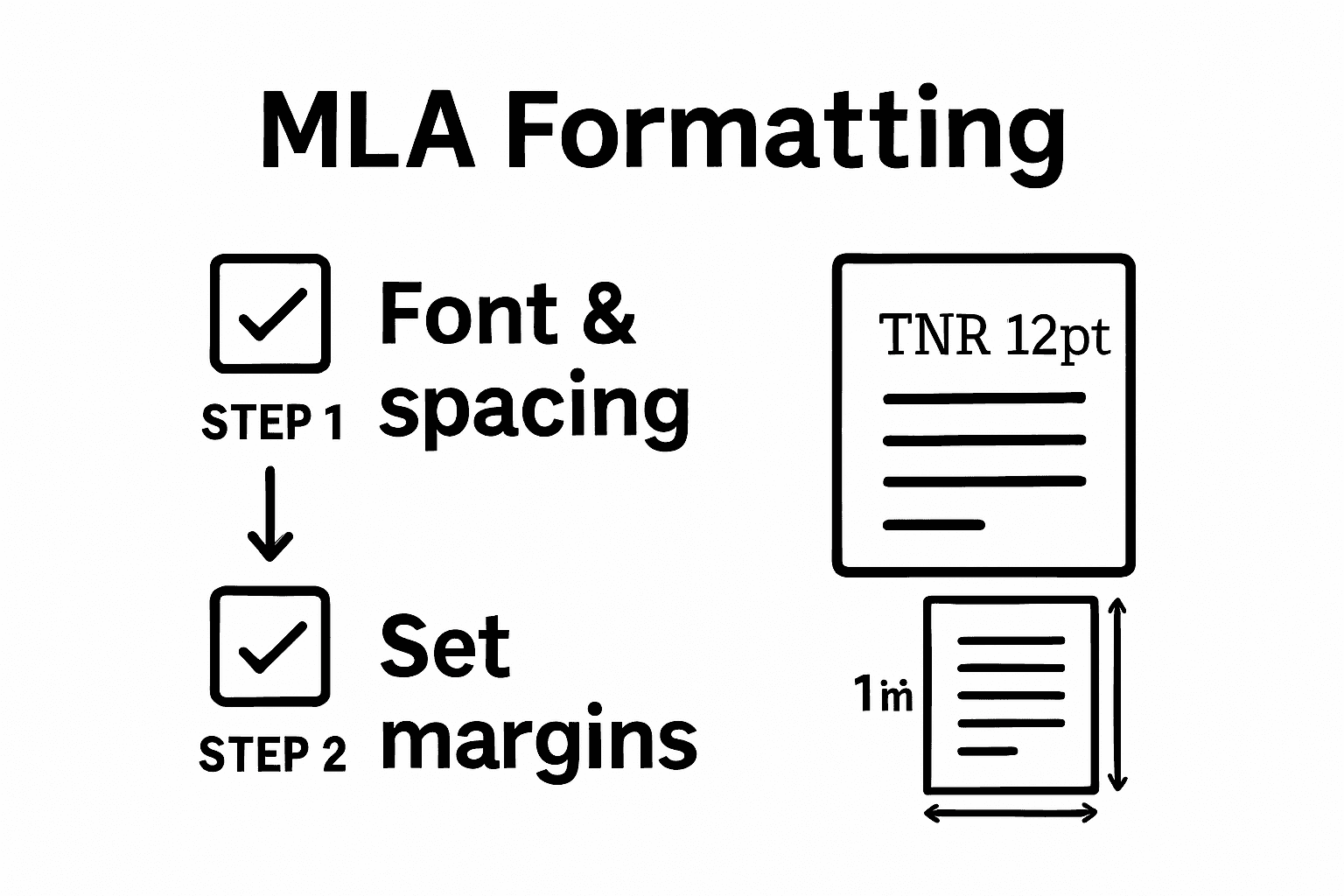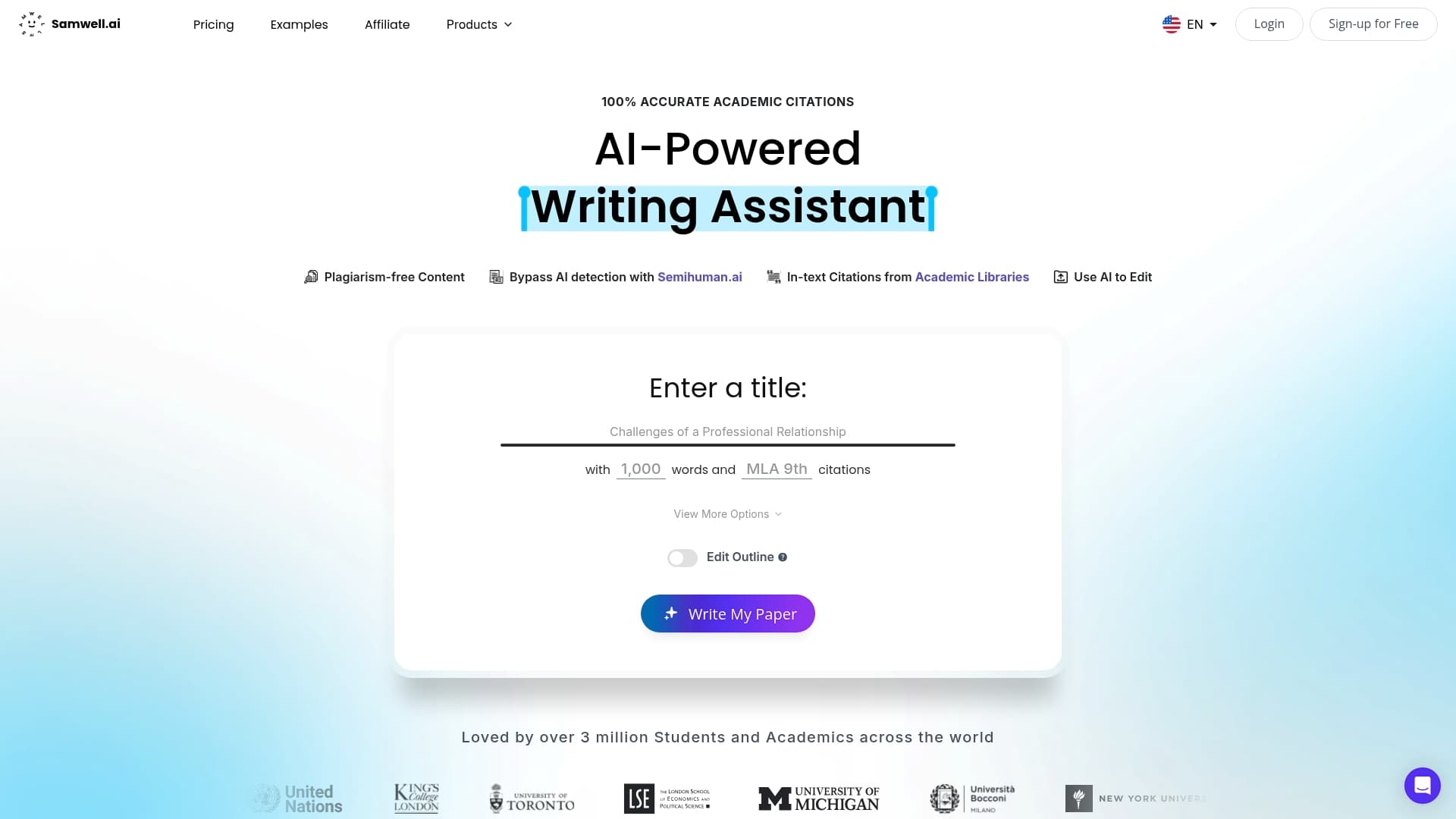Blog
Learning Materials
Create a Cover Page for Essay MLA Format: A Step-by-Step Guide
Updated: September 2, 2025

Most students think an MLA cover page is just about writing your name and date at the top. But the real challenge is following the 8 exact rules for fonts, margins, line spacing, and information placement that instructors use to decide if your work looks professional. Plenty of great papers get marked down for missing a simple detail like the required double-spacing or forgetting the precise date format.
Table of Contents
- Step 1: Gather Required Information For Your Cover Page
- Step 2: Format Your Document Settings For MLA Style
- Step 3: Arrange Text Elements On The Cover Page
- Step 4: Adjust Font And Spacing According To MLA Guidelines
- Step 5: Review And Finalize Your Cover Page For Accuracy
Quick Summary
| Key Point | Explanation |
|---|---|
| 1. Gather key information accurately | Collect essential details such as your name, instructor's name, course title, and date without errors. |
| 2. Follow MLA formatting guidelines | Use Times New Roman 12-point font, one-inch margins, and double-spacing to ensure uniformity and professionalism. |
| 3. Properly arrange cover page elements | Position your personal information at the top left and center the title, ensuring all text is aligned and double-spaced. |
| 4. Verify accuracy of details | Cross-check your information against official documents to prevent any mistakes on your cover page. |
| 5. Conduct a final review | Perform a thorough inspection of your cover page and consider seeking feedback from peers for improvement. |
Step 1: Gather Required Information for Your Cover Page
Creating a professional MLA format cover page starts with carefully collecting the essential information that will form the foundation of your academic document. This crucial first step ensures your paper begins with a clean, organized presentation that meets scholarly standards. Think of this process as assembling the key credentials that will introduce your academic work to your instructor.
Begin by identifying the specific details you will need to compile. The core information for your MLA cover page includes:
- Your full legal name
- Your instructor's complete name
- The specific course name or course number
- The current date (formatted as day month year)
Accurately recording these details requires attention to precision. Your name should be written exactly as it appears on official academic records, using standard capitalization. When noting your instructor's name, use their preferred professional title and full name. For the course identifier, refer directly to your syllabus or course catalog to ensure you capture the exact course designation.
The date formatting is particularly important in MLA style. Unlike casual writing, you will want to write the date in a formal manner: day month year (such as 15 September 2023). This consistent, unabbreviated approach demonstrates academic rigor and adheres to MLA guidelines. Avoid using numerical date formats like 9/15/2023, which can be ambiguous across different cultural contexts.
Gather these details from authoritative sources like your course syllabus, student records, or by directly confirming with your instructor. Having a digital or physical reference sheet can help prevent errors and ensure you capture each piece of information correctly. Explore our comprehensive guide on academic formatting to further refine your document preparation skills.
Verify your collected information by cross-checking each detail against your official academic documents. A successful completion of this step means you have a clear, accurate set of personal and course information ready to be precisely placed on your MLA cover page.
Step 2: Format Your Document Settings for MLA Style
Formatting your document according to MLA style guidelines is more than just a technical requirement. It demonstrates your commitment to academic professionalism and ensures your paper meets scholarly standards. This step transforms your raw document into a polished, academically acceptable manuscript that communicates your attention to detail.
Standard formatting in MLA style follows precise specifications that create a clean, uniform appearance. Begin by selecting Times New Roman as your font, set at a 12-point size. This classic typeface provides excellent readability and is widely accepted in academic circles. While some might be tempted to use more decorative fonts, academic writing demands clarity and consistency.
Document layout requires meticulous attention. Set one-inch margins on all sides of your document. Most word processing software like Microsoft Word or Google Docs allow easy margin adjustment through page setup or layout options. These uniform margins create a professional frame for your academic work, ensuring the document looks balanced and clean.
Double-spacing is another critical MLA formatting requirement. This means there should be no single-spaced sections anywhere in your document. Enable double-spacing throughout, including between paragraphs and in your bibliography. This spacing enhances readability and provides instructors space for potential annotations or feedback.
Paragraph formatting demands specific attention. Indent the first line of each paragraph by 0.5 inches using the tab key or paragraph settings in your word processor. This subtle indentation helps visually distinguish between paragraphs without additional line breaks. Discover more about precise academic formatting techniques to refine your document preparation skills.
To verify your formatting is correct, create a quick checklist:

- Font is Times New Roman, 12-point size
- One-inch margins on all sides
- Entire document is double-spaced
- First line of each paragraph indented 0.5 inches
A perfectly formatted document signals to your instructor that you understand and respect academic writing conventions.
 These seemingly small details collectively demonstrate your scholarly discipline and commitment to professional presentation.
These seemingly small details collectively demonstrate your scholarly discipline and commitment to professional presentation.
Step 3: Arrange Text Elements on the Cover Page
Arranging text elements on your MLA cover page requires precision and careful attention to specific formatting guidelines. This step transforms your collected information into a professionally structured document that communicates academic rigor and personal accountability. Think of this process as creating a formal introduction to your scholarly work.
Begin with your personal information in the top left corner of the page. Start by typing your full name, positioned flush with the left margin. Use standard capitalization and your legal name as it appears in official academic records. On subsequent lines, list your instructor's complete name, followed by the specific course name or number. Each of these lines should be double-spaced, maintaining the consistent formatting established in previous steps.
Directly beneath your course information, add the current date using the month day, year format (such as September 15, 2023). This date should align with the left margin and follow the same double-spacing principle. Precision matters here: spell out the month completely and use cardinal numbers for the day.
The paper's title represents the centerpiece of your cover page. Center the title horizontally across the page, using standard Title Case capitalization. This means capitalizing the first letter of each principal word, but leaving articles, conjunctions, and prepositions in lowercase unless they start the title. Avoid bolding, italicizing, or underlining the title. The font should remain consistent with your 12-point Times New Roman setting.
Learn advanced techniques for academic document formatting to refine your skills beyond basic requirements. Proper title placement communicates your understanding of academic presentation standards.
To verify your cover page layout, perform a quick checklist:
- Name is in top left corner
- Instructor name and course information follow
- Date is listed beneath course details
- Title is center-aligned
- All text is double-spaced
- No additional formatting on title
Your meticulously arranged cover page now serves as a professional gateway to the academic work that follows, signaling your commitment to scholarly precision and attention to detail.
Step 4: Adjust Font and Spacing According to MLA Guidelines
Precise font and spacing selections transform your document from a casual draft to a professional academic submission. MLA guidelines provide exacting specifications that ensure consistency and readability across scholarly work. Understanding these formatting nuances demonstrates your commitment to academic excellence.
Times New Roman at 12-point size remains the gold standard for MLA formatting. This classic typeface offers exceptional clarity and maintains a professional appearance. When selecting your font, resist the temptation to experiment with decorative or alternative typefaces. Academic writing demands uniformity and legibility. Most word processing software include Times New Roman as a default option, making implementation straightforward.
Double-spacing represents another critical formatting requirement. This means every line of text should have equivalent vertical space between them. Enable double-spacing throughout your entire document, including the cover page, main text, and bibliography. This spacing creates visual breathing room and allows instructors space for potential annotations or feedback. In practical terms, double-spacing typically increases document length by approximately 30 percent compared to single-spacing.
Pay careful attention to paragraph formatting. Indent the first line of each paragraph by 0.5 inches using your word processor's paragraph settings or the tab key. This subtle indentation visually separates paragraphs without additional line breaks. Avoid using extra spaces between paragraphs, as MLA style prioritizes clean, consistent formatting. Explore comprehensive guidelines for academic document preparation to refine your formatting skills.
To verify your document meets MLA formatting standards, create a quick checklist:
- Font is Times New Roman
- Font size is 12 points
- Entire document is double-spaced
- First line of each paragraph indented 0.5 inches
- No extra spaces between paragraphs
- One-inch margins maintained
These seemingly minor formatting details collectively communicate your understanding of academic writing conventions. A meticulously formatted document signals scholarly discipline and respect for established academic standards.
Step 5: Review and Finalize Your Cover Page for Accuracy
The final step of creating an MLA cover page involves a meticulous review process that transforms your draft into a polished, professional document. Think of this stage as your academic quality control checkpoint, where attention to detail can make the difference between a good and an exceptional submission.
Begin with a comprehensive visual inspection of your cover page. Step back and view the document as a whole, checking for overall visual balance and consistency. Ensure that your text is centered and aligned precisely as MLA guidelines specify. Pay special attention to the spacing between elements, verifying that each line is double-spaced and that the title sits exactly in the center of the page.
Carefully examine each text element for accuracy. Verify that personal information is exact, including your full legal name, your instructor's complete name, and the precise course title. Even a minor misspelling can create an unprofessional impression. Cross-reference your details with official academic records to eliminate any potential errors. The date should be written in full (month day, year format) and positioned exactly as specified in previous formatting guidelines.
Technology can be an excellent ally in this review process. Most word processing software offer spelling and grammar checks that can help identify potential errors. However, do not rely solely on automated tools. Discover advanced proofreading techniques for academic documents to enhance your review skills beyond basic spell-checking.
To ensure absolute accuracy, create a final verification checklist:
- Name is correctly spelled and formatted
- Instructor name is complete and accurate
- Course title matches official records
- Date is in month day, year format
- Title is center-aligned
- Font is Times New Roman, 12-point size
- All text is double-spaced
- Margins are consistently one inch
- No extra formatting on text elements
Consider asking a classmate, tutor, or instructor to perform a final review. A fresh set of eyes can often catch subtle errors that you might overlook. Remember, your cover page is the first impression of your academic work. A meticulously prepared document communicates your professionalism, attention to detail, and respect for academic standards.
Here is a checklist table summarizing the key requirements you should review before submitting your MLA cover page. Use this as a final step to ensure full compliance with MLA guidelines.
| Requirement | How to Verify | Common Mistake to Avoid |
|---|---|---|
| Name is correctly spelled/formatted | Match to official academic records | Nicknames or missing middle names |
| Instructor name is accurate | Confirm spelling and title with course syllabus/email | Leaving out title or using first name only |
| Course title is exact | Compare with the course syllabus or catalog | Using incorrect course code or title |
| Date is in month day, year format | Ensure month is spelled out (e.g., September 15, 2023) | Using numerical date format |
| Title is center-aligned | Check that title is centered horizontally on the page | Left-aligning, bold, or underlining |
| Font and size correct | Must be Times New Roman, 12-point | Other fonts or sizes |
| Double-spacing applied | Verify throughout the cover page and essay | Single spacing or extra line breaks |
| One-inch margins on all sides | Confirm with page layout settings | Narrower or uneven margins |
Remove MLA Format Stress With Seamless Academic Tools
Struggling with cover page details or perfection in MLA formatting? You are not alone. Many students find it overwhelming to gather requirements, double-check margins or align every element just right. Every step matters to your academic reputation. Even the smallest mistake on your cover page or inconsistent formatting can cause unnecessary anxiety, lost points, and wasted hours. What if you could skip that hassle and focus only on your ideas?

Now is the perfect moment to let Samwell.ai handle the technical demands of academic writing for you. Samwell.ai’s advanced AI-driven platform checks every box from MLA cover page precision to formatting and originality. Easily generate essays that always meet citation standards using clear tools like the Power Editor and guided MLA outlines. Stop second-guessing your document’s compliance—trust https://samwell.ai to elevate your work instantly. Discover how simple and mistake-free student writing can be. Get started and see your next cover page crafted with confidence.
Frequently Asked Questions
What information do I need to include on an MLA format cover page?
You need to include your full legal name, your instructor's complete name, the specific course name or course number, and the current date formatted as day month year.
How should I format the text on my MLA cover page?
Use Times New Roman font at 12-point size, set one-inch margins on all sides, and ensure the entire document is double-spaced with the first line of each paragraph indented by 0.5 inches.
What is the correct way to arrange the elements on the cover page?
Personal information should be aligned to the top left corner, followed by the instructor's name, course information, and the date. The title should be centered horizontally on the page.
How can I verify that my cover page meets MLA formatting guidelines?
Conduct a visual inspection for alignment and spacing, check accuracy of personal details, and create a checklist to ensure all formatting specifications, such as font type, size, and double-spacing, are met.
Recommended
Generate essays with Samwell.ai
Whether you’re a publisher, professor, journalist, or student, let us tailor a plan just for you.Most Read Articles

Your Guide to Help Writing a Essay Successfully
Expert tips for help writing a essay - from crafting a thesis to structuring your essay effectively.

How to Write Critical Thinking Essay: Expert Tips
Expert tips for writing a critical thinking essay. Learn how to structure, choose topics, and use evidence effectively.'

How to Write a Good Hook: A Step-by-Step Guide
Master the art of crafting a good hook with our guide. Create compelling openers for a memorable first impression.
